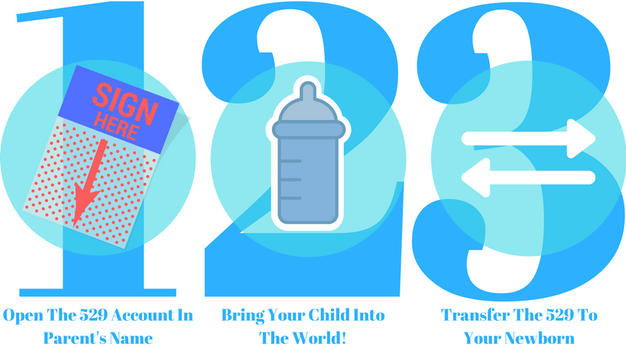Today’s parents are starting their college funds much earlier than previous generations. In fact, a Vanguard study of its 529 plan account owners shows that the majority of today’s parents open their baby’s 529 college fund before they are born or shortly after.
These parents definitely deserve a round of applause for starting their account during, or prior to, the turbulent first year of parenting.
The majority of today’s parents are starting their 529 plan when their child is unborn or right at birth
Many parents are interested in starting their baby’s college fund during pregnancy. During this time, parents are long-term oriented in their planning due to the constant reminder of drastic life changes already occurring or on the near-term horizon (i.e., the bun in the oven).
These expectant parents often also have more free time to plan for the future than before pregnancy (the “nights out with the girls” seem to decline as the baby grows).
For parents that don’t start their child’s 529 fund when they are a newborn, the Vanguard report indicates that the median beneficiary age when the 529 account is initially funded is 3.5.
What’s an extra 3.5 years though, right?
Well, assuming a 7% – 7.5% annualized return of an age-based investment fund, and monthly contributions of $200, waiting 3.5 years could result in an almost $20,000 decrease in total savings! For some families, that can amount to a full year’s worth of college.
Waiting 3.5 years from birth to start your child’s college fund could result in $20,000 less in total savings
While there are many great ways to save for college, the 529 college savings plan is one of the most flexible and tax-advantaged ways to do so. However, 529 plans require the social security number of the plan’s beneficiary, which does not exist at the time for your unborn child.
The earliest you can apply for your child’s social security number is at the hospital when they are born, so this can prevent expectant families from opening their child’s 529 plan before they are born.
Opening a 529 plan requires a social security number, which will not be available for your unborn child
Depending on your state of residence, processing your child’s social security number application can take between one and six weeks, and the Social Security Administration recommends that you expect to wait an additional two weeks to receive your card. This means that you may have to wait up to two months before you have your child’s social security number.
Obtaining you newborn’s social security number may take weeks or months after their birth
The problem with waiting two months is that parents seem to lose sight of long-term planning after bringing the little one home. Top priorities become feeding, sleeping, diapers…feeding, sleeping, diapers…feeding, sleeping – you get the idea.
However, there are several hacks that expectant parents can use to help them start, or prepare to start, their baby’s 529 college savings account before they are born, so they don’t miss out on the first 3.5 years of compounding growth.
Use A Savings Account For Your Unborn Child’s Fund
While a savings account will not earn comparable returns to an investment fund in a 529 account, it can be a good way to get started with your contributions without requiring your unborn child’s social security number.
You can use automatic withdrawals and/or transfers from your checking account into an existing or new savings account, which will get you in the habit of regularly contributing.
Parents can also use popular person-to-person payment tools, such as Venmo, to crowdsource contributions from friends and family. This can be especially helpful at baby showers during pregnancy.
Using a savings account for your unborn baby’s college fund has several drawbacks, in addition to the lower returns of savings accounts relative to 529 plans.
Savings accounts earn much lower returns (<1%) than investments in a 529 account (>5%)
The risk that you will delay setting up your newborn’s 529 account until your child is older still exists with this option. If you regularly contribute to the savings account, it mitigates this risk some, but you may still wind up missing out on several years of investment returns while you are getting around to transferring the funds into a 529 plan.
If you decide to use an existing savings account, rather than a new one dedicated just to college savings, you run the risk of commingling your “college savings” funds with your other general savings.
Not only is record-keeping difficult with a catch-all savings account, but you also run the risk of inadvertently dipping into your baby’s college fund due to the ease of making withdrawals from a savings account (e.g., no penalties). This could wind up ruining some of your hard work.
Using a savings account for your unborn child’s college fund makes it easier to inadvertently withdraw savings
The same risks exist when using a payments tool like Venmo to get college gift contributions from your friends and family. Those funds can get lost with your other general funds in the P2P platform and never make their way into a 529 account.
In summary, a savings account is better than not saving at all and can be an effective way to get started before your child is born, but only if you follow through with the 529 account setup and fund transfer after your child is born. If you do not follow through with the 529 account setup and fund transfer, it can wind up being equivalent to not saving.
Open A 529 Account For Your Unborn Child
Expectant parents do not necessarily have to have the social security number of their unborn child to open a 529 account. Parents can list themselves, or if the family already has a child, the unborn baby’s sibling as the beneficiary.
In either case, the beneficiary can be easily changed to the future newborn at any time after they are born.
There are a few limitations to consider when going this route, which we will discuss below. However, using a family member’s social security number can be a simple way to open your child’s 529 college fund before their birth.
Parents can list themselves as the 529 beneficiary and transfer the account to their unborn child after birth

Transferring beneficiaries is easily accomplished by filling out a beneficiary change form with your 529 program administrator, which can usually be done online. When transferring the 529 account to a sibling, there are generally no tax consequences or other penalties to consider.
Transferring beneficiaries can usually be accomplished by filling out an online form with your 529 program
In many 529 programs, you can transfer all or a portion of funds from one 529 plan to another. If the 529 plan is set up in the parent’s name, transferring the entire balance is an easy solution. If the 529 is in a sibling’s name, it may be tough to parse out what was saved for whom, but you can always get things on track with future contributions.
Tax Issues When Opening A 529 For Your Unborn Child
If you list a parent or other family member as the original beneficiary before transferring a 529 account to your newborn, there are some tax implications that you may want to consider. When a 529 beneficiary is transferred to a younger generation, such as is the case from parent to child, the transfer is considered a “gift” in the eyes of the IRS.
If your “gift” is over $15,000 in any particular year, then you may be required to reduce your $11.58M lifetime gift tax exclusion by the amount that your “gift” exceeds $15,000. So, if you transfer your 529 account worth $20,000 to your child, you may be required to lower your lifetime gift tax exclusion by $6,000 (from $11.58M to $11.574M).
Transferring over $15K in a 529 account from parent to child can reduce the parent’s lifetime gift tax exclusion
There is an exclusion for 529 plans that prevents the consequence described above. You can contribute 5 years’ worth of contributions at once and still avoid the reduction in the lifetime gift tax exclusion. This is a concept known as “superfunding.”
Effectively, you can transfer up to $75,000 ($15,000/year x 5 years) at once without triggering a reduction in your lifetime tax exclusion. You can still contribute to the account afterward, but you can’t exceed $15,000 of contributions in any of the next five years without reducing your lifetime gift tax exclusions.
These amounts often change, so be sure to look up the most recent data or consult your favorite CPA if you feel like this issue may apply to you.
The IRS allows you to “superfund” your child’s 529 account by transferring up to $70,000 at one time
For a family that is expecting their first child and intends to contribute $200 a month to their unborn child’s 529 fund, creating the 529 account before the child is born and listing themselves as the beneficiary can be done with minimal risk.
The account would likely remain below the $15,000 gift tax cut-off for several years and below the $75,000 superfunding gift tax limit through at least middle school.
Transfer your 529 plan within a few years of your child’s birth to avoid lowering your lifetime gift tax exclusion
So, all of you expectant parents out there that plan to save for your children’s college, open the 529 account before your child is born – before the house catches fire, the tornado moves into your living room, and your lack of sleep turns you into a zombie!
A little bit of effort on the front end could be worth $20,000 by the time your child graduates high school!
Love,
SavvyFi
P.S. Are you an employer looking to set up a way for your employees to make gift-giving tech really count toward past, current, or future education expenses? Let’s talk!
About SavvyFi: SavvyFi is a user-friendly fintech platform that makes it easy for employers to provide college savings and student loan benefits to their employees. Because the company’s platform is “zero-touch” to HR — without any complicated systems, integrations, or paperwork — SavvyFi unlocks education financing capabilities to even the smallest employers that would not otherwise be able to offer these benefits.
Disclosure: Third-party quotes shown may not be representative of the experience of all SavvyFi customers and do not represent a guarantee of future performance or success.





